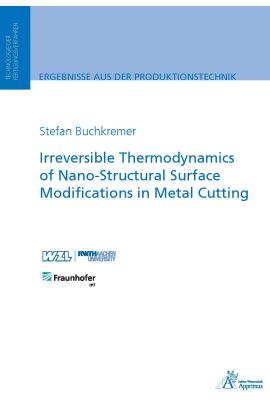Mechanical loads acting on technical components usually develop maxima in the surfaces, where the material properties determine the part integrity. The mechanical properties of metals are functions of the local microstructure, which may alternate during manufacturing. In particular in metal cutting high thermo-mechanical loads make structural modifications almost unavoidable. However, with respect to surface structures, the industrial tool and process design is still dominated by iterative empirical approaches. These hinder comparisons of manufacturing technologies and descriptions of technology chains. Accordingly, industry demands predictive models with degrees of abstraction allowing their application to different technologies.
The goal of this thesis was to develop a model for structural surface modifications in metal cutting. The research hypothesis stated that predicting these modifications by a local thermodynamic potential is a sufficient abstraction of the process, so that other technologies could potentially be described as well.
The validation of the hypothesis included three steps: i) Experimental identification of structural modification mechanisms, ii) analytical formulation of a thermodynamic potential as well as prediction of modifications and iii) correlation of material loads with industrially relevant surface modifications, i.e. compilation of process signature components. Accordingly, in i) → ii) a specific industrial problem was reduced to the underlying thermodynamics, whose validity reaches beyond industry. In ii) → iii) the obtained thermodynamic understanding was used to consult industry. Therefore, the formal scientific approach consisted of an induction followed by a deduction.
The tests in i) showed that under the investigated conditions dynamic recrystallization (DRX) yielded the formation of nano-crystalline surface layers (white layers) during cutting AISI 4140 (42CrMo4). In ii) the kinetics describing the transformation of mechanical energy into interface energy – the driving force of DRX – were analytically modeled by the thermodynamic Helmholtz potential, which considers plastic deformation, dissipation, thermal conduction as well as the associated production and flow of entropy. DRX was quantitatively predicted in finite element simulations. Finally, in iii) process signature components for the residual stress state were compiled. The proposed models were successfully validated by experimental surface nano-structures.
| Autor | Buchkremer, Stefan |
|---|---|
| Lieferzeit | 3-4 Tage |
| Gewicht | 0.235 kg |
| Erscheinungsdatum | 17.03.2017 |
Technologie der Fertigungsverfahren
Irreversible Thermodynamics of Nano-Structural Surface Modifications in Metal Cutting
Kurzbeschreibung
The goal of this thesis was to develop a model for structural surface modifications in metal cutting. Cutting tests on steel AISI 4140 (42CrMo4) showed that dynamic recrystallization (DRX) formed nano-crystalline surface layers. The kinetics of DRX were analytically modeled by the thermodynamic Helmholtz potential, considering the internal energy as well as the production and flow of entropy. Finally, DRX was predicted in finite element simulations and process signature components were compiled.

